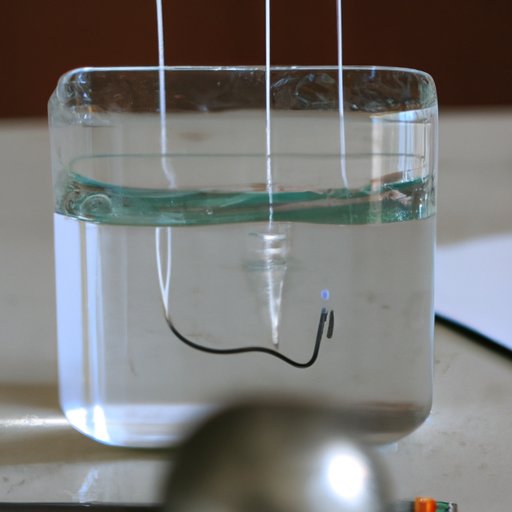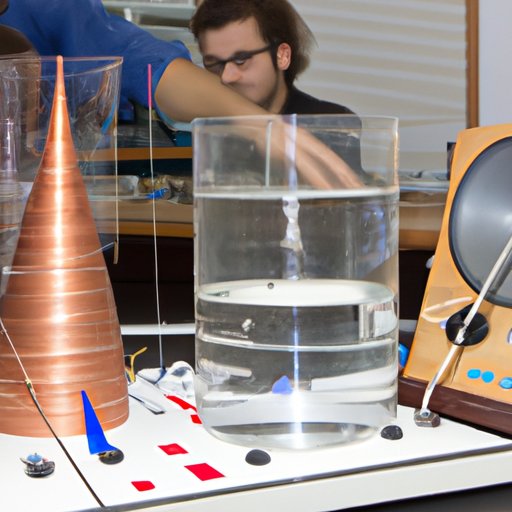Introduction
The speed of sound is an important physical phenomenon that has been studied for centuries. It affects everything from musical instruments to communication underwater. But what is the speed of sound in water and how does it compare to the speed of sound in air? This article will explore the physics behind sound travel in water, investigate the factors that affect the velocity of sound in water, and compare the speed of sound in water and air.

Exploring the Physics of Sound Travel in Water
Before we can explore the speed of sound in water, we must first understand the physics behind sound waves. A sound wave is a mechanical wave that is produced when an object vibrates. The vibrations cause disturbances in the surrounding medium, which then propagate away from the source as a wave. These disturbances are known as compressions and rarefactions and they move through the medium at a certain speed. The speed of sound in any given medium depends on the properties of that medium.
In water, sound moves through the medium in much the same way as it does in air. Compressions and rarefactions are created by the vibrations of the source and these disturbances move away from the source at a certain speed. However, the speed of sound in water is much faster than in air due to the different physical properties of the two mediums.
How Fast Does Sound Travel Through Water?
The average speed of sound underwater is approximately 1,484 meters per second (4,800 feet per second). This is more than four times faster than the speed of sound in air, which is approximately 343 meters per second (1,126 feet per second) at sea level.
However, the speed of sound in water is not constant and can vary depending on a number of factors. These factors include temperature, salinity, pressure, and frequency.
A Look at the Speed of Sound Underwater
Temperature is one of the most significant factors that affects the speed of sound in water. As the temperature increases, the speed of sound also increases. For example, at 25°C (77°F), the speed of sound in water is 1,503 meters per second (4,942 feet per second). At lower temperatures, the speed of sound decreases. At 0°C (32°F), the speed of sound is 1,457 meters per second (4,769 feet per second).
Salinity and pressure also have an effect on the speed of sound in water. As the salinity and pressure increase, the speed of sound also increases. Other factors such as turbulence, sediment, and dissolved gases can also affect the speed of sound in water, but their effects are usually much smaller than those of temperature, salinity, and pressure.

Investigating the Speed of Sound in Water
The role of frequency is another factor to consider when examining the speed of sound in water. The frequency of a sound wave is related to its wavelength, and the speed of sound in water is related to the wavelength of the sound wave. In general, lower frequency sound waves have longer wavelengths and travel faster in water than higher frequency sound waves.
The distance between the source and receiver is also an important factor. As the distance increases, the speed of sound decreases because of the effects of attenuation. Attenuation is the weakening of a sound wave over distance due to absorption and scattering. Therefore, the speed of sound in water may be affected by the distance between the source and receiver.
Comparing the Speed of Sound in Water and Air
The speed of sound in water is much faster than the speed of sound in air. This is due to the different physical properties of the two mediums. Water is denser and more viscous than air, so sound waves travel faster in water than in air. Additionally, the speed of sound in water is affected by temperature, salinity, and pressure, whereas the speed of sound in air is primarily affected by temperature.
The speed of sound in water also varies depending on the frequency of the sound wave. Low frequency sound waves travel faster in water than high frequency sound waves. This is due to the fact that low frequency sound waves have longer wavelengths, which are less affected by attenuation.

Examining the Factors That Affect the Velocity of Sound in Water
As mentioned earlier, the speed of sound in water is affected by a number of factors. Temperature, salinity, pressure, frequency, and distance all play a role in determining the velocity of sound in water. Each of these factors affects the speed of sound in different ways.
Temperature affects the speed of sound in water by increasing or decreasing the density of the medium. As the temperature increases, the density of the water decreases, resulting in an increase in the speed of sound. Conversely, as the temperature decreases, the density of the water increases, resulting in a decrease in the speed of sound.
Salinity and pressure also have an effect on the speed of sound in water. As the salinity and pressure increase, the speed of sound also increases. This is due to the fact that the increased salinity and pressure cause the water molecules to become more tightly packed, resulting in an increase in the speed of sound.
Frequency also plays a role in determining the speed of sound in water. Low frequency sound waves travel faster in water than high frequency sound waves due to their longer wavelengths. Finally, the distance between the source and receiver can also affect the speed of sound in water due to the effects of attenuation.
Conclusion
In conclusion, the speed of sound in water is much faster than in air due to the different physical properties of the two mediums. Temperature, salinity, pressure, frequency, and distance all affect the speed of sound in water in different ways. Low frequency sound waves travel faster in water than high frequency sound waves due to their longer wavelengths. Finally, the distance between the source and receiver can also affect the speed of sound in water due to the effects of attenuation.
Overall, understanding the speed of sound in water is essential for many applications, including communication and navigation underwater. By understanding the physics of sound travel in water and the factors that affect its velocity, engineers and scientists can better design systems and devices that rely on the transmission of sound waves in water.
(Note: Is this article not meeting your expectations? Do you have knowledge or insights to share? Unlock new opportunities and expand your reach by joining our authors team. Click Registration to join us and share your expertise with our readers.)
